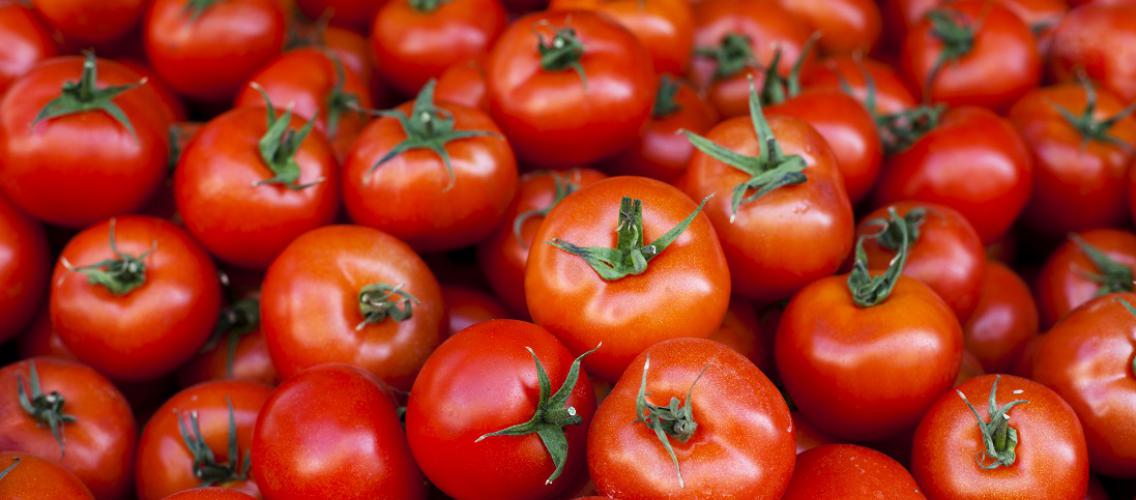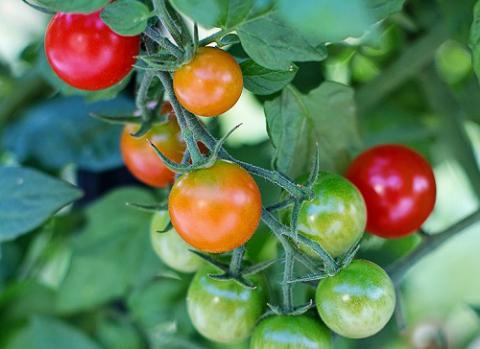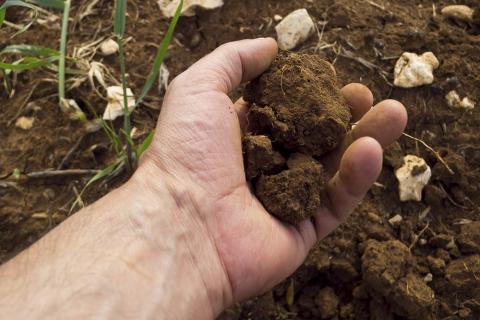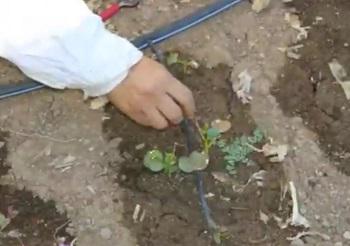
Growing Tomatoes
University of Arizona Pinal County Cooperative Extension

Mid-February is an excellent time to transplant tomato seedlings for an early-summer harvest. Tomatoes are not an easy crop to grow in the desert. Soil problems, watering requirements, and plant nutrition can be serious constraints to good production. But, as the many gardeners who successfully harvest excellent crops each year have proven, it is possible.
The secret to producing good tomatoes in the desert is to get them planted early and expect to finish harvesting before the heat of summer sets in. Planting early means putting out transplant sets in February, babying the plants through any late-season frosts that might occur, and pushing the plants hard to get maximum production before the high temperatures arrive in June. While frosts and freezes in February can make for anxious moments, planting early is definitely the best way.
Growing tomatoes in garden soil is a challenge because tomatoes are simply not well adapted to the low deserts of Arizona. If they were, there would be a viable field-grown tomato industry in Arizona. Tomatoes do not do well in southern Arizona because of the high temperatures of summer, the alkalinity of the soil, and the bright sun that easily burns the tender fruit. If you want to produce a good eating tomato, you must contend with these obstacles.
Tomatoes set fruit only when night temperatures are above 55 degrees Fahrenheit and when daytime temperatures do not exceed 90 degrees Fahrenheit. Because of these temperature limitations, the total production season of a tomato plant is quite narrow and the successful gardener must make good use of this time to get in a good crop.
The best way to plant tomatoes is to set out 6-inch transplants beginning in mid-February in the low-desert areas and mid-March in the cooler higher elevation areas.
Tomatoes can be planted from seeds successfully, but seeding requires an additional six weeks to get the plants germinated and up to size. This means that seeds must be placed in the ground, or in pots for transplants, in January with adequate cold protection to ensure the plants will be ready to produce fruit at the earliest possible time.

The short-season varieties which will produce fruit in less than seventy days are the best for our area. The Cherry-type varieties and Early Girl are good examples of short-season varieties. Columbia and Rosa are also good varieties, but these plants are extremely hard to find. Longer-season varieties are quite risky because of the looming hot weather waiting to sear late developing fruit. Celebrity is a popular variety and has proven consistent from year-to-year. Many avid tomato gardeners like it for its quick growth, good fruit setting capability, and flavorful fruit.
The larger fruited varieties, like Beefstake and Better Boy, should probably be avoided because they seem to produce a lot of vines but little fruit. There are some of you out there that absolutely love these varieties and can coax them into fruiting. For many growers in our climate, they simply do not meet expectations.
To beat the summer heat, it is important that tomato plants get off to a good start quickly. Proper soil preparation before planting, good nutrition, and timely irrigation during the growing season will help build a productive vine in a short amount of time.
All tomatoes require good light in order to produce effectively, but they must be protected from the harsh, burning sunlight of summer. Many successful tomato gardeners plant their vines with an eastern exposure so that the plants get adequate sunlight during the less-harsh morning hours while being protected from the intense heat of the afternoon. If you prefer to plant out in the open, rig a shade cloth of nursery fabric or burlap over the plants to protect both the vines and the fruit from the afternoon heat. Stay away from planting beds next to a masonry wall with a western exposure - these areas almost always spell disaster for tomatoes.

Good soil preparation will encourage the development of the deep-root system necessary to provide water and nutrients during the fruiting season. Our desert soils can easily become compacted making it difficult for plants to develop an adequate foundation for later growth. Loosen the soil by spading or tilling down to at least twelve inches and work in two to four inches of composted manure to help keep the soil from compacting again after the next irrigation. Roots need not only water and nutrients, but also air. A compacted soil, which limits the availability of these essentials, will slow and stunt the development of tomato plants.
Good soil fertility is essential. The new crop will need adequate nitrogen for growth, but too much can burn tender roots and slow development. It is best to work in ammonium phosphate fertilizer during final soil preparation and before planting. This will allow the plant to have adequate amounts of, both, nitrogen and phosphorus as it begins the season. Additional nitrogen can be added a little at a time during the growing season to ensure that the plant does not run short at critical times. Nitrogen is best added during irrigation sessions so that the water will carry the nitrogen down into the root system.
Protect your young, tender plants from cold and frost damage by placing a tall cage made of construction wire around the plant and cover the cage with a clear plastic to give a greenhouse effect. The plastic should be loose enough to provide some air circulation but tight enough to prevent frosty air from touching the plant. During warm days, loosen the plastic or remove it so that the plants will not burn from too much heat. The plastic should only be in place long enough to prevent frost damage. Once the danger of frost is past, it should be removed.
Other devices can be used to provide cold-weather protection. There are a number of frost-related products sold in garden stores that will provide protection. Some people use plastic milk containers filled with water to provide early warmth and protection for small plants. During the day, the sun heats the water inside the containers. The warm water, in turn, provides heat during the cold night time hours to protect the plant.

Proper irrigation is essential. Blossom-end rot on the fruit and fruit cracking are considered to be the result of growth spurts followed by growth checks. Growth checks are usually caused by heat and irregular irrigation. Ensure that the soil moisture is adequate during the entire growing season, but do not keep the soil too wet or root rot may occur. The decision to irrigate or not to irrigate is a critical step in the management of tomatoes.
The soil around tomato roots should remain moist, but not sloppy wet. The lush leaves and stems of the tomato require substantial amounts of water to support the process of transpiration, the life process that plants use to keep themselves cool. Because the roots are constantly picking up water, the supply needs to be replenished regularly. The frequency and duration of irrigation is specifically dependent upon the type of soil in which the plant is growing. Sandy soils require more frequent irrigation, perhaps on a daily or every-other-day cycle, while clay soils may need to be irrigated only once a week.
To determine when to irrigate in your garden, dig down with a shovel or probe with a soil auger to a depth of about six inches and check the moisture levels in the soil. If the soil forms a tight ball and leaves a wet outline on your hand when you squeeze it, hold off irrigating until the ball of soil, while still cool to the touch, begins to crumble at the edges. The length of irrigation should be long enough to fill the entire root zone of the plant. Most tomato roots will be found in a band from ground level to about eighteen to twenty-four inches. Each irrigation should send water to at least this depth. Check your moisture depth with a probe or shovel. A probe will slip easily into moist soil but stop abruptly when it reaches dry soil. Place your fingers at soil level before pulling out the probe and you will be able to measure the depth of your irrigation.
It will be highly important to also manage the concentration of naturally-occurring salts in the soil by watering deep enough to leach these water-soluble chemicals down and out of the root zone. Tomatoes are quite sensitive to high salt levels in the water and soil.
Good tomatoes grown fresh on the vine are possible in the desert as long as we understand the basics of good plant care.
Related Resources
-
Growing Edibles - Yavapai County Cooperative Extension

